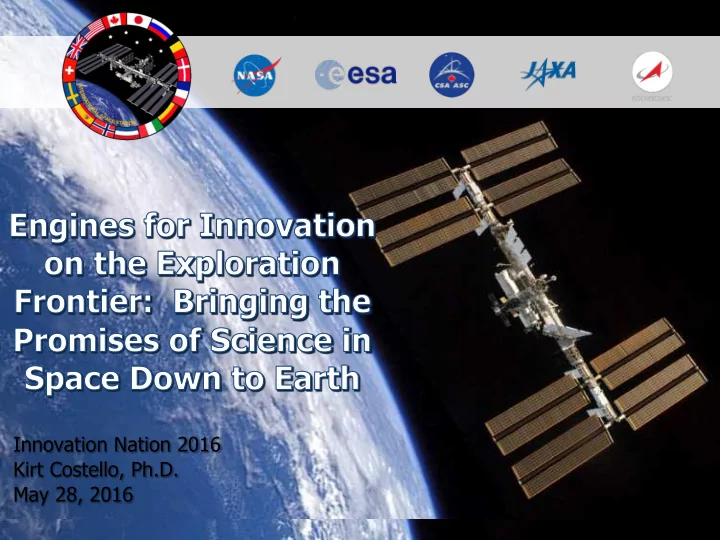

Innovation Nation 2016 Kirt Costello, Ph.D. May 28, 2016
Why do humans explore? 2 Source: ISS Program Scientist
When civilizations stop exploring… they cease to exist “Only those who will risk going too far, can possibly find out how far one can go.” - T. S. Eliot 4 3 Source: ISS Program Scientist
Exploration technology and discovery in new environments are linked – but science takes more time Charles Darwin, HMS Beagle , ca. 1831 ( OOS 1859) 4 Captain James Cook, HMS Resolution , Ca. 1771
Nations Explore… in order to advance • Exploration drives technological breakthroughs and scientific discoveries that benefit society. • Without exploration, the cycle of advancement is broken. • The ISS Partnership has transformed exploration from an effort for the advancement of individual nations, to an endeavor committed to the advancement of humankind. 5 Source: ISS Program Scientist
What kind of benefits come from research in space? Scientific Discovery Enabling Future Exploration Benefits for Humanity 6 Source: ISS Program Scientist
International Space Station Spacecraft Mass: ~925,000 lb (~419,000 kg) Spacecraft Pressurized Volume: 32,333 ft 3 (915 m 3 ) Altitude: ~260 miles (~415 km) Inclination: 51.6° Velocity: 17,500 mph (28,200 kph) Science Capability: Laboratories from four international space agencies – 7 US, Europe, Japan, and Russia.
ISS Research Accomplishments PSF Approved (Expeditions 0 – 42, December 1998 – March 2015, PSF Approved July 2015) • Expeditions 0 – 42 – 1922 Investigations • 607 NASA-led investigations • 1158 International-led investigations – >2484 investigators – >1605 scientific publications (journal, conference proceedings, and grey literature) 95 participating countries/areas – Research Discipline of ISS Investigations by Partner Agency: Expeditions 0-42 December 1998 – March 2015 Biology & Biotechnology 100% 90% Earth & Space Science 80% 70% Educational & Cultural Fluid Shifts, One-Year Mission 60% Activities 50% Human Research 40% 30% Physical Science 20% Technology Development 10% & Demonstration 0% CSA ESA JAXA NASA/U.S. Roscosmos ACE-H2 8 4 40 115 45 93 Source: ISS Program Scientist
New Knowledge and Benefits 9 Source: ISS Program Scientist
Physical Sciences: Convection Combustion Fluids: No density or buoyancy driven Convection! 10 Source: ISS Program Scientist
11
12
Physical Sciences: Convection Boiling Water on Earth vs. Microgravity Source: ¡ISS ¡Program ¡Scien0st ¡
C OMBUSTION PHYSICS M ATERIALS S CIENCE EML Electromagnetic Levitator MSL Materials Science Lab Multi-user Drop Combustion Apparatus (MDCA) / Combustion Integrated Rack (CIR) Directional Solidification Dendritic Formation Smectic Islands
Biology: Cells in Space µ G Changes: Fluid distribution Gene expression Signal transduction Locomotion Differentiation Metabolism Glycosylation 1 G 1 G Cytoskeleton Tissue morphogenesis 15 Courtesy of Neal Pellis
Human Physiology: Response to Spaceflight • Neurovestibular • Cardiovascular Astronauts experience a spectrum of adaptations • Bone in flight and postflight • Muscle • Vision • Immunology Balance disorders Cardiovascular deconditioning • Nutrition Decreased immune function Muscle atrophy • Behavior Bone loss Impaired vision • Radiation 16 Source: Dr. Clarence Sams, Human Research Program
TSIS (2017) h t r a E LIS (2016) SAGE III (2016) ISERV (2012) MUSES (Launch To Be Assigned) METEOR (2015) CATS (2015) ECOSTRESS (2017) HDEV (2014) GEDI LIDAR (2018) RapidSCAT (2014) ASIM (2017) OCO-3 (Launch To Be Assigned) GEROS (2018) Information as of May 2015
ISS RapidSCAT (Rapid E ARTH S CIENCE Scatterometer))for sea surface winds Data products downloadable worldwide CATS (Cloud-Aerosol Transport System) Lidar for aerosols and cloud depth
The Engine for Innovation on the Exploration Frontier is a Profound understanding of Uniqueness of Place. 19
Enabling Commerce in LEO • Stimulates new markets that were unachievable in the past. • Creates new stakeholders in spaceflight. • Ensures strong industrial capability for future spaceflight and related industries. • Allows cross-pollination of ideas, processes and best practices between partners of equal standing. 20 Source: ISS Program Scientist
Enabling Future Exploration 21
Source: ISS Program Scientist Materials Test Bed - MISSE materials test beds have allowed materials to be tested on the space station that have then been applied to commercial aerospace, including the white protective coating used on the SpaceX Dragon cargo module and a different material that is being used to protect the Mars Curiosity’s critical power unit. 43
Source: ISS Program Scientist 3-D Printing in Zero-G is an experiment that allows researchers to study how a 3-D printer can work well enough in space to produce useful replacement parts to support future exploration and long duration missions. 44
24
Robotic Refueling Mission (RRM) is an external ISS technical demonstration experiment that paves the way for future robotic refueling missions. It demonstrates robotic refueling tasks and servicing technologies in a zero-g environment by using CSA’s ISS Special Purpose Dexterous Manipulator (also known as “Dextre”) to validate tasks, tools, and techniques needed to repair “legacy” satellites not designed to be refueled in orbit. Robotic refueling extends the lifetime of satellites, allowing owners and operators to gain additional years of use from assets already operating in space. 25 Source: ISS Program Scientist
ISS Information Resources http://www.nasa.gov/iss-science/ ISS Research (Customer) Helpline Phone: 281-244-6187 Email: jsc-iss-research-helpline@mail.nasa.gov @ISS_Research ISS Research Blog “A Lab Aloft” https://blogs.nasa.gov/ISS_Science_Blog/ See the ISS over Your Town http://spotthestation.nasa.gov/
Space Station Research Explorer App • iPad • Android Apple: https://itunes.apple.com/us/app/space-station-research-explorer/id934070569?mt=8 Google Play: 27 https://play.google.com/store/apps/details?id=gov.nasa.jsc.igoal.ISSResearchExplorer&hl=en
Recommend
More recommend